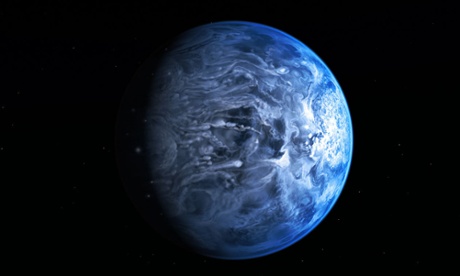
The heavens are home to an alien world that shines a deep cobalt blue in a solar system far, far away from our own.
Astronomers used the ageing Hubble space telescope
to determine the true colour of the distant world, the first time such a
feat has been achieved for a planet that circles a star other than the
sun.
Unlike the pale blue dot that harbours all known life in the
cosmos, the "deep blue dot" is an inhospitable gas giant that lies 63
light years from Earth. On HD189733b, as the planet is named, the
temperature soars to 1,000C and glassy hail whips through the air on
hypersonic winds.
Though the planet is hostile to life as we know
it, the same technique could be used to spot potentially habitable
worlds, through changes in cloud cover and other features.
Frederic Pont
at Exeter University observed the planet before, during, and after it
passed behind its star. When the planet was on either side, the
telescope collected light from the star along with light reflected from
the planet's surface. But as the planet moved behind the star, the light
it reflected was blocked out.
Using an instrument onboard the
telescope called an imaging spectrograph, Pont noticed that blue light
dimmed sharply as the planet passed behind its star, but brightened
again when it emerged on the other side. "As far as I am aware, nobody
has had actual results on the colour of an exoplanet," Pont said. "Now
we can say that this planet is blue."
The deep cobalt colouration is thought to come from a similar process to that which makes Earth look blue from space,
namely the scattering of blue light in the atmosphere. On the planet
Pont observed, the scattering is probably due to a fine mist of silicate
particles that are blown around by 7,000kph winds.
With more
advanced technology, the colour of a planet could help astronomers work
out which ones might be habitable. Most planets in our solar system are
either entirely covered by cloud, or have no clouds at all. Earth is
unusual in that roughly half of its surface is obscured by cloud, a
product of the water cycle that is essential for life.
"If you
could see the colour of an exoplanet change over time it would be very
revealing. At first, the cloud cover would be the thing to go for," Pont
said.
While future instruments could be sensitive enough to
observe the changing hues of alien worlds, there may be no suitable
telescopes in space to put them on. The Hubble observatory is more than
20 years old and was last repaired by a dedicated space shuttle mission
in 2009. Without Hubble, there are no other space telescopes that could
look at planets in visible wavelengths. Hubble's replacement, the James
Webb Space Telescope, will pick up infra-red light only.
"Most
colleagues in the field focussing on habitability concentrate on the
detection of molecules in the infra-red, like water, carbon monoxide and
methane," Pont said. "That's useful information of course, but my
opinion is that we might be giving too much weight to this compared to
visible colour, which gives a different kind of information, but maybe
just as crucial to understand the general state of an Earth-like
planet."